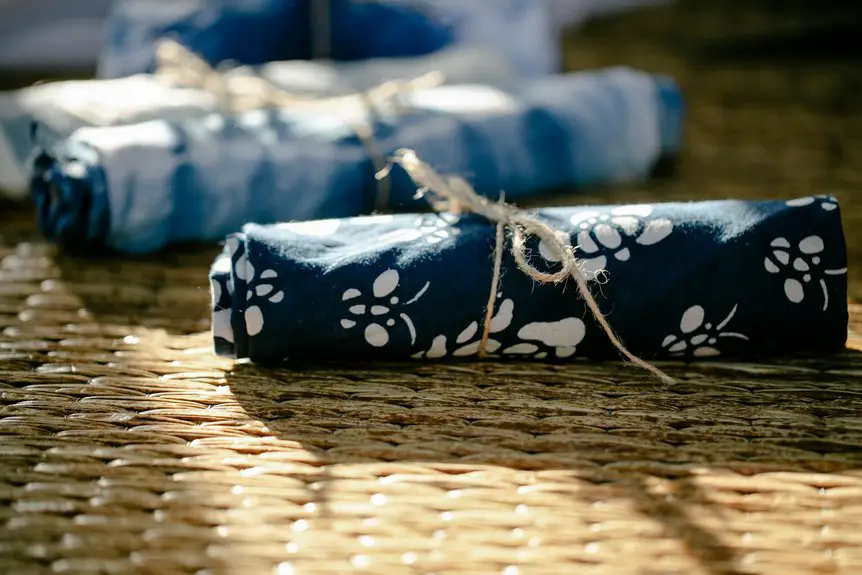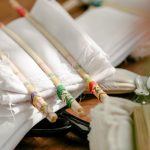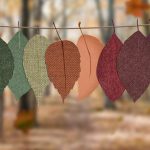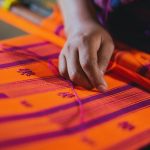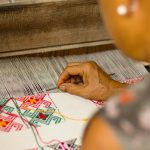To create stunning Shibori tie-dye patterns, start by choosing natural fabrics like cotton or silk for best dye absorption. Prep your fabric by washing and ironing it, then fold, twist, or bind it using rubber bands or string to form unique shapes. Apply fiber-reactive dye with techniques like dipping or brushing for bold effects. After dyeing, wash gently in cold water and air dry away from sunlight to preserve colors. Master these basics, and you’ll be ready to craft intricate, eye-catching designs with ease.
Table of Contents
Key Takeaways
- Fold, twist, or bind natural fabrics like cotton or silk to manipulate patterns before dyeing for unique Shibori designs.
- Use fiber-reactive dyes and bind fabric tightly with rubber bands or string for crisp, vibrant patterns.
- Employ folding techniques such as accordion, spiral, or triangle folds to create geometric or circular motifs.
- Apply dye by dipping, brushing, or spraying to achieve different effects from sharp to gradient patterns.
- After dyeing, wash fabric separately in cold water with gentle detergent and dry away from direct sunlight to preserve colors.
Understanding the Basics of Shibori
Shibori is a traditional Japanese dyeing technique that involves folding, twisting, or binding fabric to create unique patterns. When you try Shibori, you manipulate the cloth before dyeing, controlling how the dye reaches different areas. This process results in beautiful, organic designs that no two pieces share.
You’ll find that Shibori isn’t just about the dye—it’s about the way you prepare the fabric. Techniques like folding into triangles, twisting tightly, or binding with thread each produce distinct effects. By mastering these basic manipulations, you can experiment confidently and develop your own style.
Understanding how fabric reacts during folding and binding helps you predict patterns, making your Shibori projects more intentional and rewarding every time you dip your fabric into the dye bath.
Essential Materials and Tools for Shibori Dyeing
Once you’ve got a handle on folding, twisting, and binding fabric to shape your patterns, gathering the right materials and tools will help bring your designs to life.
Master the art of folding, twisting, and binding fabric to transform your Shibori designs into vibrant creations.
You’ll need natural fabrics like cotton, silk, or linen because they absorb dye best. Invest in quality fiber-reactive dyes for vibrant, lasting colors.
Grab rubber bands, cotton string, or wooden blocks to bind and clamp your fabric securely. Don’t forget gloves to protect your hands and a large plastic tub or bucket for dye baths.
Having a spray bottle handy lets you mist fabric evenly, while a plastic sheet or tarp keeps your workspace clean.
With these essentials ready, you’re set to create stunning Shibori patterns that truly pop.
Preparing Fabric for Shibori Techniques
Before you start folding and binding, you’ll want to prepare your fabric properly to guarantee the dye adheres evenly and the colors stay vibrant.
Begin by washing your fabric without fabric softener to remove any sizing, oils, or dirt that could block dye absorption. Once clean, dry it completely or work with damp fabric for certain Shibori styles that benefit from moisture retention.
If you’re using natural fibers like cotton, silk, or linen, they’ll take the dye best. Avoid synthetic fabrics, as they often resist dye.
Iron your fabric to remove wrinkles, making it easier to fold and bind neatly. Finally, consider pre-soaking your fabric in a mordant solution if your dye requires it; this helps fix the color and enhances durability.
Now you’re ready for the creative process!
Step-by-Step Guide to Popular Shibori Patterns
Now that your fabric is ready, you’ll learn how to fold it to create stunning Shibori patterns.
You’ll also explore different ways to apply dye for unique effects.
Finally, you’ll get tips on revealing your designs without ruining the surprise.
Folding Techniques Explained
Mastering just a few folding techniques can transform your fabric into striking Shibori patterns.
Start by folding your cloth into simple shapes like triangles or rectangles to create crisp lines and geometric designs. Accordion folds work well for repetitive patterns; fold the fabric back and forth evenly, then bind tightly.
For circular motifs, try twisting or spiral folding—pinch the center and twist the fabric around it before securing. You can also combine folds, like layering a triangle fold over an accordion, to add complexity.
Remember, the tighter you fold and bind, the more defined your patterns will be. Experiment with different folding methods to discover unique textures and shapes that suit your style.
Folding is your first step to crafting beautiful Shibori art.
Dye Application Methods
Once you’ve folded and bound your fabric, you’ll apply dye to bring your Shibori patterns to life. You can use dipping, brushing, or spraying methods, each giving distinct effects. Dipping saturates fabric evenly, brushing offers control for detailed areas, and spraying creates soft gradients. Remember to wear gloves and work over a protected surface. Let the dye soak in for vibrant colors, then rinse and dry your fabric thoroughly.
| Method | Effect | Best For |
|---|---|---|
| Dipping | Even coverage | Large, simple patterns |
| Brushing | Controlled detail | Small, intricate designs |
| Spraying | Soft gradients | Subtle, blended effects |
| Combining | Mixed effects | Complex, layered looks |
| Stamping | Repeated motifs | Geometric, repetitive |
Pattern Unveiling Tips
Three simple steps will help you reveal your Shibori patterns with striking clarity.
First, carefully unwrap your fabric once the dye has set, ensuring you don’t disturb the folds or clamps prematurely.
Second, rinse your fabric under cold water to remove excess dye; this prevents colors from blending and keeps patterns crisp.
Third, gently untie or unfold your fabric to disclose the design. For popular patterns like Arashi (pole-wrapping), look for diagonal stripes; for Itajime (fold-and-clamp), expect geometric shapes.
To enhance contrast, dry your fabric in indirect sunlight.
Remember, patience during disclosure preserves your pattern’s sharpness and detail.
With these steps, you’ll consistently showcase the bold, intricate designs Shibori is known for.
Tips for Achieving Vibrant and Precise Designs
To get vibrant and precise Shibori designs, start by choosing high-quality fabrics that absorb dye well.
Make sure you use the right dye concentration to achieve bold colors without bleeding.
Finally, mastering your folding techniques will help you create sharp, clear patterns every time.
Choose High-Quality Fabrics
Fabric quality plays an essential role in how vibrant and detailed your Shibori tie-dye designs will turn out. When you choose high-quality fabrics, the dye absorbs more evenly, resulting in sharper patterns and richer colors.
Natural fibers like cotton, silk, and linen work best because they soak up dye better than synthetic materials. Look for fabrics with a tight weave to prevent bleeding and guarantee crisp lines. Avoid blends with polyester or other synthetics, as they often resist dye, leading to dull or uneven results.
Pre-wash your fabric to remove sizing or chemicals that might block dye absorption. By selecting the right fabric, you set the foundation for stunning Shibori patterns that hold color brilliantly and last longer.
Use Proper Dye Concentration
Although selecting the right fabric sets the stage, your dye concentration determines how vivid and sharp your Shibori patterns appear. If the dye is too diluted, your designs will look washed out; too strong, and colors may bleed, losing detail. Aim for a balanced dye mix to achieve crisp contrasts and vibrant hues. Test small fabric scraps first to find your perfect ratio. Here’s a quick guide to help you visualize:
| Dye Concentration | Color Intensity | Pattern Sharpness |
|---|---|---|
| Low (1:10) | Pale | Fuzzy |
| Medium (1:5) | Moderate | Clear |
| High (1:2) | Bold | Sharp |
| Full Strength | Very Bold | Very Sharp |
Adjust concentration based on fabric type and desired effect for best results.
Master Folding Techniques
Mastering folding techniques often makes the biggest difference in creating vibrant and precise Shibori designs. When you fold your fabric carefully, you control how the dye reaches each section, resulting in sharp, striking patterns.
Start by choosing simple folds like accordion or triangular folds to practice precision. Keep your folds crisp and even; use clips or rubber bands to hold them firmly in place. The tighter and more uniform your folds, the clearer your design will be.
Experiment with layering folds to create complex patterns, but always maintain consistent pressure. Remember, the way you fold directly affects dye absorption, so take your time.
Caring for Your Shibori-Dyed Creations
Caring for your Shibori-dyed creations guarantees their vibrant patterns stay vivid and beautiful over time.
Always wash your pieces separately in cold water to prevent dye bleeding onto other fabrics. Use a gentle detergent free of bleach or harsh chemicals to protect the fibers and colors.
Wash Shibori separately in cold water with gentle, bleach-free detergent to preserve colors and prevent bleeding.
Avoid wringing or twisting the fabric; instead, gently press out excess water. When drying, lay your Shibori flat or hang it in a shaded area to prevent sun fading.
Iron on a low setting if needed, placing a cloth between the iron and fabric to avoid direct heat.
Frequently Asked Questions
Can Shibori Techniques Be Applied to Synthetic Fabrics?
You can apply Shibori techniques to synthetic fabrics, but results might differ since they absorb dye less effectively than natural fibers. You’ll need special dyes designed for synthetics to achieve vibrant, lasting patterns on those materials.
What Are the Best Natural Dyes for Shibori Dyeing?
You’ll find the best natural dyes for Shibori include indigo, madder root, and turmeric. These dyes offer vibrant colors and react well with cotton or silk, helping you create stunning, lasting patterns effortlessly.
How Long Does Shibori Dye Typically Take to Set?
You might think shibori dye sets instantly, but it actually takes time. Typically, you’ll want to let it set for at least 6 to 8 hours, or even overnight, to achieve vibrant, lasting colors.
Is It Possible to Layer Multiple Shibori Patterns on One Fabric?
Yes, you can layer multiple Shibori patterns on one fabric. Just let each dye set completely before adding another layer, so the colors don’t bleed. This way, you’ll create beautifully complex, unique designs.
Are There Eco-Friendly Alternatives to Traditional Shibori Dyes?
You know what they say, “Waste not, want not.” You can use natural dyes from plants like indigo, turmeric, or walnut shells. They’re eco-friendly, vibrant, and safer for you and the environment.
- Where Can I Buy High-Quality Percale Sheets? A Shopper’s Guide - July 14, 2025
- Where to Buy Percale Sheets: The Top Retailers for Every Budget - July 14, 2025
- Are Percale Sheets the Best Option for You? A Comprehensive Review - July 14, 2025

